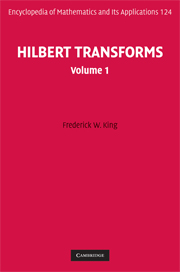Book contents
- Frontmatter
- Contents
- Preface
- List of symbols
- List of abbreviations
- 1 Introduction
- 2 Review of some background mathematics
- 3 Derivation of the Hilbert transform relations
- 4 Some basic properties of the Hilbert transform
- 5 Relationship between the Hilbert transform and some common transforms
- 6 The Hilbert transform of periodic functions
- 7 Inequalities for the Hilbert transform
- 8 Asymptotic behavior of the Hilbert transform
- 9 Hilbert transforms of some special functions
- 10 Hilbert transforms involving distributions
- 11 The finite Hilbert transform
- 12 Some singular integral equations
- 13 Discrete Hilbert transforms
- 14 Numerical evaluation of Hilbert transforms
- References
- Author index
- Subject index
2 - Review of some background mathematics
Published online by Cambridge University Press: 04 May 2010
- Frontmatter
- Contents
- Preface
- List of symbols
- List of abbreviations
- 1 Introduction
- 2 Review of some background mathematics
- 3 Derivation of the Hilbert transform relations
- 4 Some basic properties of the Hilbert transform
- 5 Relationship between the Hilbert transform and some common transforms
- 6 The Hilbert transform of periodic functions
- 7 Inequalities for the Hilbert transform
- 8 Asymptotic behavior of the Hilbert transform
- 9 Hilbert transforms of some special functions
- 10 Hilbert transforms involving distributions
- 11 The finite Hilbert transform
- 12 Some singular integral equations
- 13 Discrete Hilbert transforms
- 14 Numerical evaluation of Hilbert transforms
- References
- Author index
- Subject index
Summary
Introduction
The principal objective of this chapter is to present some of the essential basic mathematical background that is employed in later sections. A good deal of this material should be straightforward for a well trained undergraduate mathematics or physics major; however, there are a few slightly more advanced topics that are treated concisely. For these topics, collateral reading in a standard text is highly recommended. Some suggestions of where to start additional reading are provided in the end–notes. The mathematically talented reader could bypass most of this chapter and skip to the derivations in Chapter 3.
Almost all the mathematical notation employed can be found in the List of symbols; please consult that list for the definition or for the first use of a particular symbol. Some common notational devices are reviewed first, and this is followed by a concise description of some of the more important mathematical tools, such as Fourier analysis, complex variable theory, and the basics of integration theory, i.e. topics that are central to later developments. Further extensions of some of these tools are given later as needed.
- Type
- Chapter
- Information
- Hilbert Transforms , pp. 11 - 82Publisher: Cambridge University PressPrint publication year: 2009

